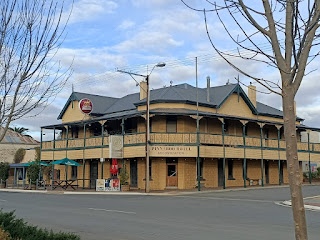Before I write about the history of Griffith I must mention about the people who lived here before European settlers.
It would appear that for about 60,000 years the Wiradjuri people roamed the area, moving between the two rivers, living off the land, eating small animals, fruit, nuts and fish. The Wiradjuri were a small population, having an ecological and spiritual connection with the land with the elders having authority in social and religious ceremonies.
However, with the coming of the white man, it all changed, and life as they knew it could no longer continue.
The speedy occupation of the land had a devastating effect on the Aboriginal communities. They were dispossessed of their lands, and their culture was fractured. They had no defence against the white invaders, and many died or were killed. Those that survived went on to work on the properties of the settlers.
At the 2021 census only 1,436 people of Aboriginal descent live in Griffith.
Ideas for conserving water in this area began about 1855, and some small canals were dug using water from the Murrunbidgee River. But it was not until the early 1900s that the government seriously put into place legislature to build dams and canals in which to provide irrigation in the Riverina area. The Murrumbidgee Irrigation Scheme (later called the Murrumbidgee Irrigation Area) came into being and work took place from 2006 onwards. The government also purchased most of the land, at low prices, from the settlers who lived here.
The government then divided the land into small blocks of about 50 acres and leased the farms to people who were interested in starting a farm. The farms were widely advertised in order to attract people to the area. Soldier settlers also took up leases when they returned from war in 1918.
It all sounds rosy! In fact it went pear shaped from the beginning. I could write pages about everything that went wrong with the system, but instead will try and encapsulate the events in a few paragraphs.
As the government leased the land to farmers they could charge whatever price they liked, and did so. They organised for the farmers to buy horses and machinery, and lent them money. They set up advisers to tell farmers what to grow on their farms, and the crops and fruit trees died due to the advice not being correct. The soldiers/settlers were often shell shocked and/or not used to agricultural work. And the government bungles were gigantic!
Consequently the farmers' debts mounted up, as they had no income to pay back the loans for machinery, seeds, fertilisers, water etc. By 1926 less than 30% of the original settler farmers were still on their land, all the others had walked off in despair. The government ended up writing off most of the debts.
But all was not lost. People were allowed to buy their 50 acres instead of leasing the land, and took out loans to do so. Many people who had debts insisted on paying them off, although it took until 1946 to do so, but it meant that they owned the land and machinery. People started to experiment with different crops, including rice, and many grew both fruit and vegetables (fruit salad farms).
The large Italian community supported each other which meant they paid off their debts quickly. They were also used to working small farms in Italy and quickly learnt how to successfully manage their small plots of land here. They also planted grape vines and helped start the wine industry here.
After World War II the area boomed, and has continued to do so.
There was one hiccup in the late 1970s when one or two people suddenly became very rich. Crops of marijuana were discovered in the Griffith area. The growing conditions for it were ideal, good soil and plenty of water. Local people were angry about it but there was no action from the authorities, except for minimal jail terms and fines. A man who led the fight against the illegal crop being grown here was murdered, which meant the government had to take action. However the people of Griffith, and especially anyone of Italian descent, had to live with a slur against them for some years.
And now to our visit to the Griffith Pioneer Park Museum. It was an amazing place with buildings full of old machinery and streets with buildings that had been moved to the museum. And inside the old buildings relevant displays had been set up.
The entrance to the museum. A settlers house.
There was a large hall set aside for an Italian display of stories and exhibits. Fascinating. It gave people such an insight into the lives of the early farmers.
The coloured metal sculpture depicts the Murray cod.
Very old cars!
Lots of machinery.
The typical four roomed house that was initially built in Griffith, which had fibro sheets on the walls. A health and safety risk now.
Some of the buildings in the recreated street.
Now I cannot remember the name of this shop. However, the Post Office, bakery, grocery store, blacksmith, etc, were all set up as they would have been when they were part of the early town of Griffith.
A farmer's small house.
There was a big knitting and crochet group here that met once a week. This is what they produced, an amazing selection of crafted objects.
Plenty of old tractors and farm machinery in this museum.
A steam engine. Fascinating.
Plus the old dunny, with a windmill behind. No spiders there though.
Finally, the end!
Except there will be more tomorrow.
We are staying another day, which will be lovely, but Walter will spend the morning locating two new tyres for the car. Plus the cost. I ran over a bolt on the road and it pierced a tyre. Consequently we had to call the NRMA out to change the tyre. Why are tyres so complicated to change these days


















































